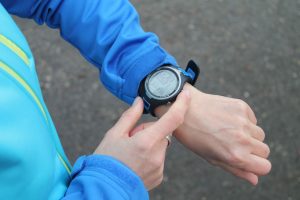Let’s start by imagining a rubber tube, packed tightly with little rubber pellets. You now take out the huge mallet that you just purchased and give one end of the tube a good whack! Due to the compact nature of the tube, much of the force exerted from the strike will travel to the other end of the tube.
Now imagine this same rubber tube is loosely packed, and we give it the same forceful whack at one end. The tube now gets squished by the mallet, flattens out, and force from the strike dissipates from the squished area in a sideways fashion. Consequently, most of the force never reaches the other end.

The reason I like this simple analogy is because it describes in simple terms, the way power is transferred through the human body in a link like fashion when running, from every foot strike (mallet hit) to arm swing (end of the tube), and vice versa.
In order to run efficiently, coordinated movement of the arms and legs must occur. This co-ordination is dependent on our core. Just like our rubber tube, the tighter our mid-section and gut are, the more effectively we’re able to transfer force and power between the upper and lower extremities; naturally improving the efficiency and economy of our running.
The beauty of this is that the more efficient we are at something, the less energy we need to expend when doing it. When it comes to training for a longer distance run, it’s essential not only to consider how much energy we can train our body to produce through our training but also how efficiently we can expend that energy. This is critical to performance.

If you doubt this, I want you to try a simple experiment for me: head down to your local swimming pool and try to swim 4 lengths of freestyle with your head up high out of the water at a moderate pace. Afterwards (if you manage to finish without shouting for the lifeguards help), take your time and resting heart rate.
Give yourself a few minutes rest.
Now, swim another 4 lengths with conventional good freestyle technique. Again, take your time and heart rate.
Which felt harder? What happened to your time (performance) and resting heart rate (efficiency) when you applied what you believed to be better freestyle technique?
Improving energy conservation and technique through greater levels of muscular endurance and strength is something that’s rarely spoken about in the endurance world. In general, the longer the duration of the event, the more important these factors become. We’re not just talking about one or two repetitions of an exercise anymore, we’re talking hundreds-thousands, if there’s an issue when it comes to technical proficiency or strength imbalances, we’re going to know about it, either immediately through sub-optimal performance, or longer term on the physio bed.
James Bigland
(Health and Fitness Adviser, Bristol University)
This blog is designed to supplement our strength and mobility videos available on our app, as part of the Bristol Run Series Support Hub.
